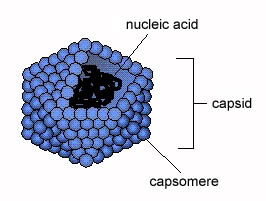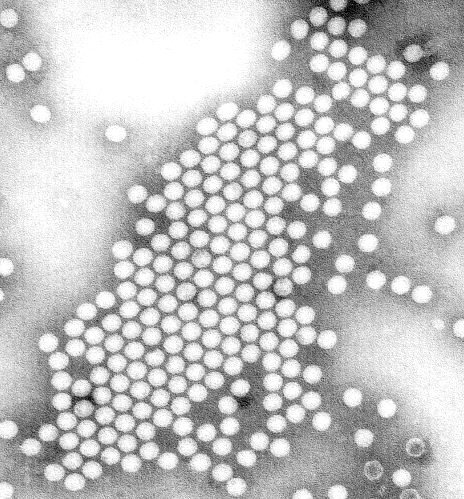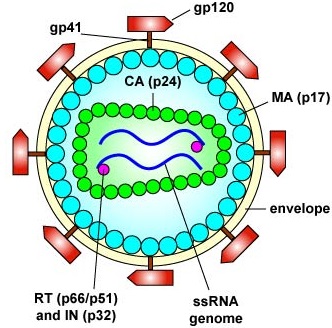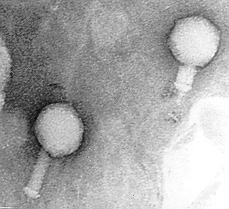10.3: Viral Structure
- Page ID
- 3234
\( \newcommand{\vecs}[1]{\overset { \scriptstyle \rightharpoonup} {\mathbf{#1}} } \)
\( \newcommand{\vecd}[1]{\overset{-\!-\!\rightharpoonup}{\vphantom{a}\smash {#1}}} \)
\( \newcommand{\id}{\mathrm{id}}\) \( \newcommand{\Span}{\mathrm{span}}\)
( \newcommand{\kernel}{\mathrm{null}\,}\) \( \newcommand{\range}{\mathrm{range}\,}\)
\( \newcommand{\RealPart}{\mathrm{Re}}\) \( \newcommand{\ImaginaryPart}{\mathrm{Im}}\)
\( \newcommand{\Argument}{\mathrm{Arg}}\) \( \newcommand{\norm}[1]{\| #1 \|}\)
\( \newcommand{\inner}[2]{\langle #1, #2 \rangle}\)
\( \newcommand{\Span}{\mathrm{span}}\)
\( \newcommand{\id}{\mathrm{id}}\)
\( \newcommand{\Span}{\mathrm{span}}\)
\( \newcommand{\kernel}{\mathrm{null}\,}\)
\( \newcommand{\range}{\mathrm{range}\,}\)
\( \newcommand{\RealPart}{\mathrm{Re}}\)
\( \newcommand{\ImaginaryPart}{\mathrm{Im}}\)
\( \newcommand{\Argument}{\mathrm{Arg}}\)
\( \newcommand{\norm}[1]{\| #1 \|}\)
\( \newcommand{\inner}[2]{\langle #1, #2 \rangle}\)
\( \newcommand{\Span}{\mathrm{span}}\) \( \newcommand{\AA}{\unicode[.8,0]{x212B}}\)
\( \newcommand{\vectorA}[1]{\vec{#1}} % arrow\)
\( \newcommand{\vectorAt}[1]{\vec{\text{#1}}} % arrow\)
\( \newcommand{\vectorB}[1]{\overset { \scriptstyle \rightharpoonup} {\mathbf{#1}} } \)
\( \newcommand{\vectorC}[1]{\textbf{#1}} \)
\( \newcommand{\vectorD}[1]{\overrightarrow{#1}} \)
\( \newcommand{\vectorDt}[1]{\overrightarrow{\text{#1}}} \)
\( \newcommand{\vectE}[1]{\overset{-\!-\!\rightharpoonup}{\vphantom{a}\smash{\mathbf {#1}}}} \)
\( \newcommand{\vecs}[1]{\overset { \scriptstyle \rightharpoonup} {\mathbf{#1}} } \)
\( \newcommand{\vecd}[1]{\overset{-\!-\!\rightharpoonup}{\vphantom{a}\smash {#1}}} \)
\(\newcommand{\avec}{\mathbf a}\) \(\newcommand{\bvec}{\mathbf b}\) \(\newcommand{\cvec}{\mathbf c}\) \(\newcommand{\dvec}{\mathbf d}\) \(\newcommand{\dtil}{\widetilde{\mathbf d}}\) \(\newcommand{\evec}{\mathbf e}\) \(\newcommand{\fvec}{\mathbf f}\) \(\newcommand{\nvec}{\mathbf n}\) \(\newcommand{\pvec}{\mathbf p}\) \(\newcommand{\qvec}{\mathbf q}\) \(\newcommand{\svec}{\mathbf s}\) \(\newcommand{\tvec}{\mathbf t}\) \(\newcommand{\uvec}{\mathbf u}\) \(\newcommand{\vvec}{\mathbf v}\) \(\newcommand{\wvec}{\mathbf w}\) \(\newcommand{\xvec}{\mathbf x}\) \(\newcommand{\yvec}{\mathbf y}\) \(\newcommand{\zvec}{\mathbf z}\) \(\newcommand{\rvec}{\mathbf r}\) \(\newcommand{\mvec}{\mathbf m}\) \(\newcommand{\zerovec}{\mathbf 0}\) \(\newcommand{\onevec}{\mathbf 1}\) \(\newcommand{\real}{\mathbb R}\) \(\newcommand{\twovec}[2]{\left[\begin{array}{r}#1 \\ #2 \end{array}\right]}\) \(\newcommand{\ctwovec}[2]{\left[\begin{array}{c}#1 \\ #2 \end{array}\right]}\) \(\newcommand{\threevec}[3]{\left[\begin{array}{r}#1 \\ #2 \\ #3 \end{array}\right]}\) \(\newcommand{\cthreevec}[3]{\left[\begin{array}{c}#1 \\ #2 \\ #3 \end{array}\right]}\) \(\newcommand{\fourvec}[4]{\left[\begin{array}{r}#1 \\ #2 \\ #3 \\ #4 \end{array}\right]}\) \(\newcommand{\cfourvec}[4]{\left[\begin{array}{c}#1 \\ #2 \\ #3 \\ #4 \end{array}\right]}\) \(\newcommand{\fivevec}[5]{\left[\begin{array}{r}#1 \\ #2 \\ #3 \\ #4 \\ #5 \\ \end{array}\right]}\) \(\newcommand{\cfivevec}[5]{\left[\begin{array}{c}#1 \\ #2 \\ #3 \\ #4 \\ #5 \\ \end{array}\right]}\) \(\newcommand{\mattwo}[4]{\left[\begin{array}{rr}#1 \amp #2 \\ #3 \amp #4 \\ \end{array}\right]}\) \(\newcommand{\laspan}[1]{\text{Span}\{#1\}}\) \(\newcommand{\bcal}{\cal B}\) \(\newcommand{\ccal}{\cal C}\) \(\newcommand{\scal}{\cal S}\) \(\newcommand{\wcal}{\cal W}\) \(\newcommand{\ecal}{\cal E}\) \(\newcommand{\coords}[2]{\left\{#1\right\}_{#2}}\) \(\newcommand{\gray}[1]{\color{gray}{#1}}\) \(\newcommand{\lgray}[1]{\color{lightgray}{#1}}\) \(\newcommand{\rank}{\operatorname{rank}}\) \(\newcommand{\row}{\text{Row}}\) \(\newcommand{\col}{\text{Col}}\) \(\renewcommand{\row}{\text{Row}}\) \(\newcommand{\nul}{\text{Nul}}\) \(\newcommand{\var}{\text{Var}}\) \(\newcommand{\corr}{\text{corr}}\) \(\newcommand{\len}[1]{\left|#1\right|}\) \(\newcommand{\bbar}{\overline{\bvec}}\) \(\newcommand{\bhat}{\widehat{\bvec}}\) \(\newcommand{\bperp}{\bvec^\perp}\) \(\newcommand{\xhat}{\widehat{\xvec}}\) \(\newcommand{\vhat}{\widehat{\vvec}}\) \(\newcommand{\uhat}{\widehat{\uvec}}\) \(\newcommand{\what}{\widehat{\wvec}}\) \(\newcommand{\Sighat}{\widehat{\Sigma}}\) \(\newcommand{\lt}{<}\) \(\newcommand{\gt}{>}\) \(\newcommand{\amp}{&}\) \(\definecolor{fillinmathshade}{gray}{0.9}\)- Describe what an animal virus consists of structurally.
- Define the following:
- capsid
- capsomere
- nucleocapsid.
- Describe how most animal viruses obtain their envelope.
- State why some bacteriophages are more complex than typical polyhedral or helical viruses.
Since viruses are not cells, they are structurally much simpler than bacteria. An intact infectious viral particle is called a virion and consists of: a genome, a capsid, and often an envelope.
Viral Genome
The viral genome is a single or segmented, circular or linear molecule of nucleic acid functioning as the genetic material of the virus. It can be single-stranded or double-stranded DNA or RNA (but almost never both), and codes for the synthesis of viral components and viral enzymes for replication. It is also becoming recognized that viruses may play a critical role in evolution of life by serving as shuttles of genetic material between other organisms.
Viral Capsid
The capsid, or core, is a protein shell surrounding the genome and is usually composed of protein subunits called capsomeres. The capsid serves to protect and introduce the genome into host cells. Some viruses consist of no more than a genome surrounded by a capsid and are called nucleocapsid or nucleocapsid (Figure \(\PageIndex{1}\)). Attachment proteins project out from the capsid and bind the virus to susceptible host cells.

The Adenovirus and Poliomyelitis viruses are examples of naked viruses (Figure \(\PageIndex{2}\)); both exhibit polyhedral structures.

Viral Envelope
Most animal viruses also have an envelope surrounding a polyhedral or helical nucleocapsid, in which case they are called enveloped viruses (Figure \(\PageIndex{3}\)). The envelope may come from the host cell's nuclear membrane, vacuolar membranes (packaged by the Golgi apparatus), or outer cytoplasmic membrane.

- Transmission electron micrograph of Rubella viruses budding from an infected host cell; courtesy of CDC.
- Transmission electron micrograph of an Influenza A virus; courtesy of CDC.
- Transmission electron micrograph of HIV; courtesy of CDC.
Although the envelope is usually of host cell origin, the virus does incorporate proteins of its own, often appearing as glycoprotein spikes, into the envelope. These glycoprotein spikes function in attaching the virus to receptors on susceptible host cells.
- Transmission electron micrograph showing envelope and glycoprotein spikes (gp120) of HIV; courtesy of CDC.
- Transmission electron micrograph showing envelope and glycoprotein spikes Coronaviruses; courtesy of CDC.
Viral Activation of Innate Immunity
To protect against infection, one of the things the body must initially do is detect the presence of microorganisms. The body does this by recognizing molecules unique to microorganisms that are not associated with human cells. These unique molecules are called pathogen-associated molecular patterns or PAMPs. (Because all microbes, not just pathogenic microbes, possess PAMPs, pathogen-associated molecular patterns are sometimes referred to as microbe-associated molecular patterns or MAMPs.)
For example, most viral genomes contain a high frequency of unmethylated cytosine-guanine dinucleotide sequences (a cytosine lacking a methyl or CH3 group and located adjacent to a guanine). Mammalian DNA has a low frequency of cytosine-guanine dinucleotides and most are methylated. In addition, most viruses produce unique double-stranded viral RNA, and some viruses produce uracil-rich single-stranded viral RNA during portions of their life cycle. These forms of viral nucleic acids are common PAMPs associated with viruses. These PAMPs bind to pattern-recognition receptors or PRRs called toll-like receptors or TLRs found within the endosomes of phagocytic cells. Viral RNA can also bind to cytoplasmic PRRs called RIG-1 (retinoic acid-inducible gene-1)and MDR-5 (melanoma differentiation-associated gene-5).
Most of the PRRs that bind to viral components trigger the synthesis of cytokines called Type-I interferons that block viral replication within infected host cells. The TLRs for viral components are found in the membranes of the phagosomes used to degrade viruses during phagocytosis. As viruses are engulfed by phagocytes, the viral PAMPS bind to TLRs located within the phagolysosomes (endosomes ). The TLRs for viral components include:
1. TLR-3 binds double-stranded viral RNA;
2. TLR-7 binds uracil-rich single-stranded viral RNA such as in HIV;
3. TLR-8 binds single-stranded viral RNA;
4. TLR-9 binds unmethylated cytosine-guanine dinucleotide sequences (CpG DNA) found in bacterial and viral genomes.
5. RIG-1 (retinoic acid-inducible gene-1) and MDA-5 (melanoma differentiation-associated gene-5), are cytoplasmic sensors that both viral double-stranded and single-stranded RNA molecules produced in viral-infected cells
Bacteriophages are viruses that only infect bacteria. Some bacteriophages are structurally much more complex than typical nucleocapsid or enveloped viruses and may possess a unique tail structure composed of a base plate, tail fibers, and a contractile sheath (also see Figure \(\PageIndex{1}\)C and Figure \(\PageIndex{2}\)E). Other bacteriophages, however, are simple icosahedrals or helical (see Figure \(\PageIndex{1}\)C).

Electron Micrograph of a Bacteriophage with a Contractile Sheath. A = normal bacteriophage and B = bacteriophage after contraction of sheath
- Transmission electron micrograph of the bacteriophage coliphage T4 courtesy of Dennis Kunkel's Microscopy.
- Discuss why viruses can only replicate inside living cells.
- Most of the PRRs for viral PAMPs are found in the membranes of the phagosomes, not on the surface of the cell.
- Why do you think this is?
- Name the primary cytokines produced in response to viral PAMPs and state how they function to protect against viruses.
Summary
- Since viruses are not cells, they are structurally much simpler than bacteria.
- An intact infectious viral particle - or virion - consists of a genome, a capsid, and maybe an envelope.
- Viruses possess either DNA or RNA as their genome.
- The genome is typically surrounded by a protein shell called a capsid composed of protein subunits called capsomeres.
- Some viruses consist of no more than a genome surrounded by a capsid and are called nucleocapsid or naked viruses.
- Most animal viruses also have an envelope surrounding a polyhedral or helical nucleocapsid that is typically derived from host cell membranes by a budding process and are called enveloped viruses.
- Specific proteins or glycoproteins on the viral surface are used to attach viruses to the surface of its host cell.
- The viral nucleic acid functions as a pathogen-associated molecular pattern (PAMP).
- Binding of viral PAMPs to host cell pattern-recognition receptors (PRRs) triggers the synthesis and secretion of anti-viral cytokines called type-1 interferons that block viral replication within infected host cells.


